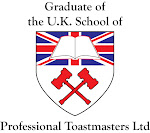History of the Toastmaster
The historical origins of the modern Toastmaster are cloaked in mystery, as there is little definitive reference documentation. In the middle ages the keeper of the wine in great houses was referred to and became known as the ‘Master of the Toast’.
The “Master of the Toast” would toast small pieces of bread before a fire, dip them into herbs and spices before stirring them into a bowl of wine to enhance its flavour.
Towards the end of the 17th century the toasting of one’s friends became an accepted custom especially to VIP’s attending banquets. Its origins can be linked to the following;
A banquet was being held in the Pump Room at Bath in the year 1649.
Two young men attending wandered into the adjacent spa where languishing in the waters was a ‘Lady of the Town’ covered in ‘little more than blushes’. One of the young men wanted to jump into the water to be with her but was prevented by his friend who scooped some water into his empty drinking vessel. There remained at the bottom of his vessel the small piece of spiced toast from the previous drink of wine. On drinking from the newly charged vessel he is reputed to have said, “Nay, though I likest not the beverage (i.e. the water from the bath) I will take toast with the lady” he then proceeded to drink the water containing the toast and entered the water.
The major-domo of old was the modern toastmaster’s predecessor. He was employed in the houses of Spanish and Italian Nobles as the ‘Manager’ The English version at this time was the ‘House Steward’ nowadays called the Butler. One of the Butlers duties was to announce guests arriving for dinner who would then be greeted and received by the Host and Hostess.
Private clubs often appointed a member to act as Toastmaster and to ensure that these Toastmasters did not over imbibe in alcohol a toastmasters glass was designed, made of thick glass but it would only hold a small measure, thus ensuring the Toastmaster remained sober!
The origin and history of the redcoat as worn by the modern Toastmaster are generally accepted as being introduced by the late William Knight-Smith. He remarked to his wife, his concern at being dressed like a headwaiter or butler, his wife suggested that he wear a red coat. Another account is that the occasion at which he changed his coat to a red one the then Prince of Wales admired it and commented favourably on it. It is also accepted that William Knight-Smith was the first to be recognised as a bone- fide toastmaster setting the scene for others to emulate.
Each and every function must be treated individually. The toastmaster’s advice is sought on many occasions. It is therefore imperative to have the knowledge of protocol and preambles for all engagements. Your toastmaster must never appear to be more important than the event at which he is officiating.
A Toastmaster must be dignified in appearance, have the ability to control large numbers of people without being too authoritarian, have a good personality, strong voice, clarity of diction and an intelligent approach to all engagements at which he officiates.
Note. In the City of London the toastmasters red coat remains a black tailcoat with the addition of the red and white sash of the City of London being worn over the right shoulder.
With thanks to Mr Graham Hunt.
Graham is both proud and honoured to be Past President of the
Association of the UK School of Professional Toastmasters.
Founder/Director UK School of Professional Toastmasters Limited
Sunday, 2 January 2011
Subscribe to:
Post Comments (Atom)


No comments:
Post a Comment